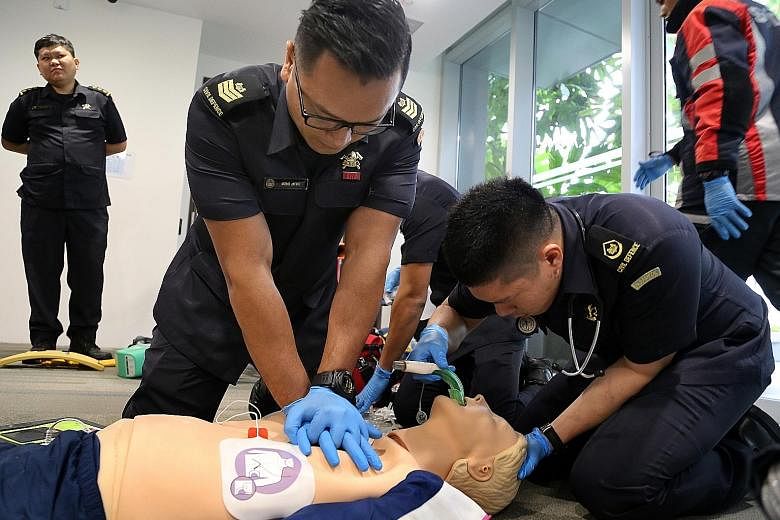From next year, fire trucks may be seen racing ahead of ambulances to help victims of cardiac arrest.
Given that they are usually the first to arrive at the scene of an emergency, firefighters will be roped in to help save lives, and more than 300 have been certified as emergency medical technicians.
This means that on top of basic first aid, they have learnt high-performance cardiopulmonary resuscitation (CPR). This is a method that uses a larger team working simultaneously to perform CPR faster and more effectively.
It is among several new measures to improve the emergency treatment of cardiac arrest victims, nearly four in five of whom now die.
The Singapore Civil Defence Force (SCDF) and Singapore General Hospital (SGH) will be implementing the new measures over a four-year period.
Currently, an ambulance takes an average of 11 minutes to reach the scene. A fire bike usually gets to the destination in half the time.
Under the new protocol, the fire bike will be joined by a fire truck, estimated to reach the scene within eight minutes, with four trained firefighters on board.
Together with paramedics, the respondents will form a "Formula One team" that "works together to ensure everything is done in less time", said Professor Marcus Ong, a senior consultant at the department of emergency medicine at SGH.
Speed is paramount in the event of a cardiac arrest as the highest chance of survival occurs in the first 10 minutes. Last year, there were more than 2,500 such ambulance emergencies, and just 21.3 per cent of the victims survived.
Prof Ong believes the new interventions will push this figure up to around 30 per cent.
Besides the deployment of firefighters, another change is to rely less on computers to assess whether a victim needs defibrillation, in which a machine is used to assess the need for a dose of electric current to the heart. Instead, paramedics will now do a manual assessment, which is quicker.
Prof Ong said that computers take 10 to 20 seconds to make a decision that a trained paramedic could do in two. "It will mean more training for our paramedics, but in these situations, every second counts," he added.
A new device will also be attached to regular ventilating systems to enhance the heart's ability to pump blood around the body.
-
2,500
There were more than this number of cases of cardiac arrest that were ambulance emergencies here last year; only 21.3 per cent of the victims survived.
Lastly, a new type of injection to correct life-threatening heart rhythms will be introduced. About 250 paramedics will be trained in the three new interventions.
Mr Zane Ang, 28, an advanced care paramedic with the SCDF, said the new measures should help to improve survival rates.
"Although there is new pressure on the paramedics, it is doable, but there are precautions we will take," said Mr Ang.
SCDF chief medical officer Ng Yih Yng said: "If untreated in a cardiac arrest emergency, there is a 98 per cent chance you will die. These interventions require more skills to train but it's to tackle a difficult problem."

